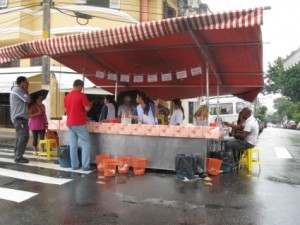
Photo © Michael Sommers.
I’m still in São Paulo, which is being subjected to precipitation of epic proportions. According to the cover story of this week’s Veja (the Brazilian equivalent of Time magazine), over the last 40 days more rain has fallen in Sampa than in the last 63 years. As chuvas (the rains) constitute the Number One topic on the news. The front pages of newspapers regularly feature stories of cars, homes, and people that are swept away in the sudden and torrential flooding that occurs.
In São Paulo, when it rains, it literally pours – usually at the end of the afternoon. Ordinarily, the sudden gathering of clouds would signal relief from the oppressive heat, but when they open up, all hell breaks loose with trees falling, power going out, and traffic jams galore. So far, 72 people have died this year in São Paulo as a result of rain; major causes of death include being killed by falling trees or drowning in sudden floods.
Pastéis are one of Sampa’s most beloved culinary delights.Aside from the rain, it also thunders and lightnings a lot. In fact, according to the same Veja article, Brazil is the world champion in terms of the number of times lightning strikes – with 57 million bolts striking last year alone. Although this makes for some very dramatic storms, fatalities also occur. In 2008, 75 Brazilians died after being hit by lightning (20 of them in São Paulo state).
I really admire the courage of Paulistanos who go about their business and pleasure relatively undaunted by the rain. Not even their enthusiasm for stopping at a street stand for a piping hot pastel has been dampened.
Pastéis are one of Sampa’s most beloved culinary delights. Light, crisp, and flaky (if made properly), these rectangular turnovers are stuffed with various fillings and then deep fried in vats of hot oil at parks, outdoor events, and, most famously, at the daily street markets held throughout the city.
Pastéis are sold at wooden stands (usually for R$2 to R$3). On the counter, you’ll always find a basket of at least a dozen sauces (ketchup, garlic, barbecue, lemon, soy, hot pepper, etc.) along with vinagrete; small containers of finely chopped tomatoes, peppers, and onions which are to be poured into the pastel once the first initial bite(s) have been taken. Stools are made available so that customers can eat (and spill) to their heart’s content. All in all, a pretty convivial experience.
The average pastéis stand offers around 15 fillings including heart of palm, pizza, escarole, and chicken with catupiry (a type of thick runny cream cheese that Paulistanos adore). In spite of endless innovations, according to surveys, most pastel aficionados prefer the two most traditional standbys – ground beef and cheese.
The classic companion to a pastel is a cup of caldo de cana (sugar cane nectar). The long stalks of sugar cane (lying in a picturesque pile) are ground before your eyes by the owner of a caldo de cana cart. The caldo is surprisingly refreshing, especially if you add lime juice – and it’s easy to linger over this classic combo if you find yourself riding out a rainstorm.